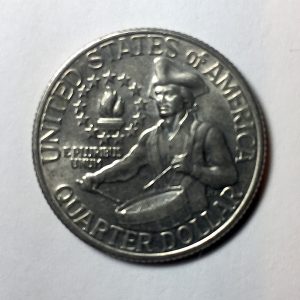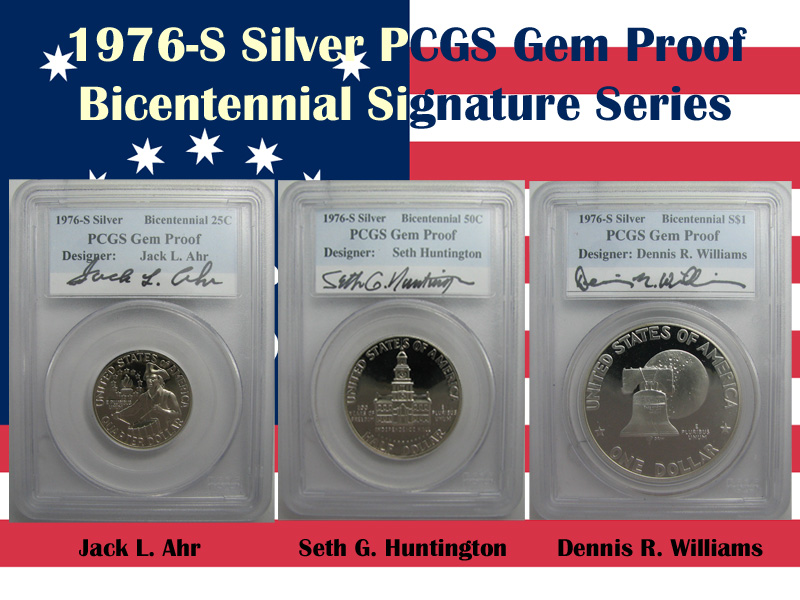My First Coin Design Change and Celebration
After the introduction of the Eisenhower Dollar, the first design change came in 1975 for the bicentennial. In the 1970s, celebrating the bicentennial was a significant event. The planning began in the last 1960s and picked up in 1972. The entire nation planned for a celebration that spread across every community.
The American Revolution Bicentennial Administration logo was everywhere, including the official medals the U.S. Mint produced. But that is not all the U.S. Mint produced as part of the bicentennial celebration.
In 1973, Congress passed the law allowing the U.S. Mint to change the reverse design of the quarter, half-dollar, and dollar coins to honor the bicentennial in 1975 and 1976. The coins will be dated 1776-1976 before they revert to their original designs.
My first introduction to a design change was the Drummer Boy reverse on the Washington Quarter. I liked the design more than the original eagle design on the reverse, and it continues to be one of my favorite designs.
As a collector and a newly minted driver, I saved money from my after-school jobs to purchase uncirculated coins and the sets with the bicentennial coins.
In 2001, there was a reunion of the artists who created the designs. Jack Ahr (quarter), Seth Huntington (half-dollar), and Dennis Williams (dollar) attended the celebration. PCGS had the three artists sign labels inserted into slabs with proof versions of the coins they designed. I was able to pick up a set on the aftermarket.
Because of the hype, and the potential to increase seigniorage, the U.S. Mint overproduced these coins. They also made proof and silver proof sets so plentiful that they remained on sale through 1986. The U.S. Mint ended up melting over 600,000 sets.
Suggested Reading: To learn more about the legislation that created the Bicentennial coinage program, read “14 Bits: The Story of America’s Bicentennial Coinage” by David Ganz (ISBN 978-0914478638).
The Bicentennial celebration was a national event to remember. Nearly every community issued medals. The Bureau of Engraving and Printing joined in and changed the reverse of the $2 Federal Reserve Note to an interpretation of John Trumbull’s Declaration of Independence. The BEP issued the notes on April 13, 1976, and it is possible to find uncirculated notes postmarked on that date. July 4, 1976, is another popular postmark for bicentennial collectibles, especially postmarks from Philadelphia.
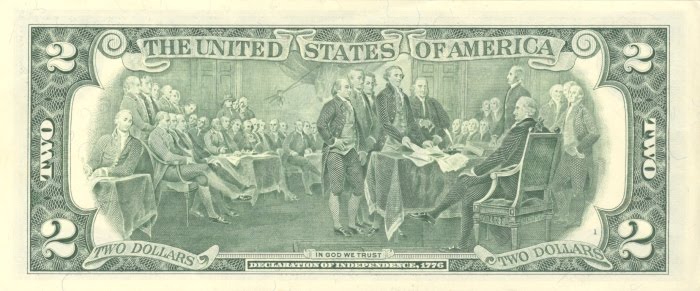
Reverse of the Series 1976 $2 Federal Reserve Note features an engraved modified reproduction of the painting The Declaration of Independence by John Trumbull.
Even though the circulating commemorative was generally successful, the concept would not return until the beginning of the 50 State Quarters program in 1999.
Weekly World Numismatic News for January 24, 2021
 On Wednesday, Joseph R. Biden Jr. became the 46th President of the United States. It was the 46th time since 1789 that a new President took the oath of office. Regardless of the circumstances leading up to the inauguration, this was the 59th ceremonial inauguration. There were eight other inaugurations following the death of presidents and Gerald Ford’s inauguration following Richard M. Nixon’s resignation.
On Wednesday, Joseph R. Biden Jr. became the 46th President of the United States. It was the 46th time since 1789 that a new President took the oath of office. Regardless of the circumstances leading up to the inauguration, this was the 59th ceremonial inauguration. There were eight other inaugurations following the death of presidents and Gerald Ford’s inauguration following Richard M. Nixon’s resignation.
For numismatics, the new administration means there will be leadership changes at the Department of the Treasury. The president nominated Janet Yellen as the Secretary of the Treasury. When confirmed, Yellen will become the 78th Treasury Secretary. The Series 2021 Federal Reserve Notes will feature Yellen’s signature on the right side.
The president has not nominated a Treasurer of the United States. Currently, the office has been vacant since the resignation of Jovita Carranza in January 2020. When the Senate approves a nominee, that person’s signature will appear on the Federal Reserve Notes’ left side.
Officially, the Director of the U.S. Mint is an appointment of five years. David J. Ryder, the current director, was confirmed in April 2018. Ryder can serve until 2023. Although Ryder could have resigned at the end of the previous administration, he chose not to. It is unclear if Ryder, a Republican, will continue to serve as Director. The U.S. Mint’s press office responded to a question about Ryder’s plans:
Finally, the Director of the Bureau of Engraving and Printing is not an appointed position. BEP’s Directors are members of the government’s Senior Executive Service as career government employees. Len Olijar is the current and 25th Director of the Bureau of Engraving and Printing.
And now the news…
 → Read more at 9news.com.au
→ Read more at 9news.com.au
 → Read more at cnn.com
→ Read more at cnn.com
 → Read more at wgbh.org
→ Read more at wgbh.org
 → Read more at qrius.com
→ Read more at qrius.com
 → Read more at aljazeera.com
→ Read more at aljazeera.com
 → Read more at boingboing.net
→ Read more at boingboing.net
Weekly World Numismatic News for January 17, 2021
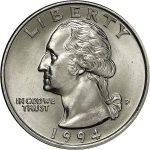 The president has signed the last numismatic-related bill this past week. On January 13, 2021, the president signed the Circulating Collectible Coin Redesign Act of 2020 (Public Law No. 116-330). It was the last possible day to sign the bill. If he did not sign it, the bill would be subjected to a pocket veto.
The president has signed the last numismatic-related bill this past week. On January 13, 2021, the president signed the Circulating Collectible Coin Redesign Act of 2020 (Public Law No. 116-330). It was the last possible day to sign the bill. If he did not sign it, the bill would be subjected to a pocket veto.
- H.R. 1923: Circulating Collectible Coin Redesign Act of 2020
Sponsor: Rep. Barbara Lee (D-CA)
LAST ACTION: Signed by the President and became Public Law No: 116-330. — Jan 13, 2021
The law will require the U.S. Mint to redesign the quarters’ reverse through 2030, starting in 2022.
Prominent American Women Quarters
For the quarters issued between 2022 and 2025, “The design on the reverse side of each quarter dollar issued under this subsection shall be emblematic of the accomplishments and contributions of one prominent woman of the United States.” The U.S. Mint will issue “up to” five quarters per year and confer with several groups to determine who receives the honor.
United States Semiquincentennial Coins
The United States will celebrate its seniquincentennial (250th Anniversary) on July 4, 2026. In celebration of the event, the law states that the U.S. Mint will issue the following coins:
- QUARTERS: 2026 quarters “with up to five different designs emblematic of the United States semiquincentennial.” One quarter must be design to be emblematic of the contribution of a woman or women.
- DOLLARS: orders the Mint to issue “$1 dollar coins with designs emblematic of the United States semiquincentennial.” These dollar coins will be issued in addition to the Native American and Innovation dollars.
Youth Sports Program
The law requires the U.S. Mint to celebrate youth sports with changes to the quarter and half-dollars to correspond to the Summer Olympic games of 2028 and the Winter games of 2030. This program will run from 2027 through 2030.
- QUARTERS: Up to five coins issued each year “shall be emblematic of one sport played by American youth.”
- HALF-DOLLARS: Up to five coins issued each year “emblematic of one Paralympic sport.”
- MEDALS: The law authorizes the U.S. Mint to create “medals with designs emblematic of the sport honored with the issuance of the coin.”
Medals for the 2028 Olympic Games in Los Angeles
The law authorizes the U.S. Mint “to design and manufacture medals for awarding at the 2028 Olympic Games in Los Angeles, California.” The law makes it the first time in the modern Olympics history that the U.S. Mint will create the games’ medals. Previously, the Olympic committees had a private vendor create the medals. According to the International Olympic Committee website, medals for the games played in the United States were created by the following:
| Year | Games | Location | Minter of the Medals |
|---|---|---|---|
| 1904 | Summer | St. Louis | Diege & Clust |
| 1932 | Summer | Los Angeles | The Whitehead & Hoag Co. |
| 1932 | Winter | Lake Placid | Robbins Company |
| 1960 | Winter | Squaw Valley | Herff Jones |
| 1980 | Winter | Lake Placid | Medallic Art Co. |
| 1984 | Summer | Los Angeles | Jostens, Inc |
| 1996 | Summer | Atlanta | Reed and Barton |
| 2002 | Winter | Salt Lake City | O.C. Tanner |
Silver Bullion Coins
The new law allows the U.S. Mint to continue to make the five-ounce silver bullion coins that correspond to each of the quarter and half-dollar programs. Interestingly, the silver hockey-puck-sized coins appear to be popular and will continue to be available to collectors and investors.
Also added to the law is the ability to strike factional silver bullion coins with the same designs. It is uncertain if a half-ounce or quarter-ounce silver coin will sell, but we will find out.
Obverse of the Coins
George Washington will continue to appear on the obverse but “be designed in a manner, such as with incused inscriptions, so as to distinguish it from the obverse design used during the previous quarters program.”
The bill includes similar language for the image of John F. Kennedy on the 2026 Semiquincentennial half-dollar.
And now the news…
 → Read more at beloitdailynews.com
→ Read more at beloitdailynews.com
 → Read more at news.justcollecting.com
→ Read more at news.justcollecting.com
 → Read more at ancient-origins.net
→ Read more at ancient-origins.net
 → Read more at express.co.uk
→ Read more at express.co.uk
One more bill from the 116th Congress
 With the 116th Congress gaveled to a closed, the only numismatic-related bill left to watch is H.R. 1923, Circulating Collectible Coin Redesign Act of 2020. The House of Representatives agreed with the Senate’s amendment on December 31, 2020, and sent it to the White House on January 1, 2021. The president has until January 13, 2021, to sign the bill into law. If he does not sign the bill, it becomes the victim of a pocket veto.
With the 116th Congress gaveled to a closed, the only numismatic-related bill left to watch is H.R. 1923, Circulating Collectible Coin Redesign Act of 2020. The House of Representatives agreed with the Senate’s amendment on December 31, 2020, and sent it to the White House on January 1, 2021. The president has until January 13, 2021, to sign the bill into law. If he does not sign the bill, it becomes the victim of a pocket veto.
- H.R. 1923: Circulating Collectible Coin Redesign Act of 2020
Sponsor: Rep. Barbara Lee (D-CA)
Passed the House of Representatives — Sep 22, 2020
Passed the Senate with amendments — Dec 17, 2020
LAST ACTION: Presented to President. — Jan 1, 2021
For a description of what coinage is included in H.R. 1923, see the September 2020 Numismatic Legislation Review.
Weekly World Numismatic News for January 10, 2021
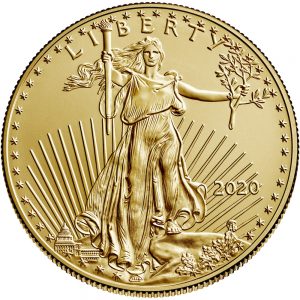 The Weekly World Numismatic News return finds that although 2020 was a stressful year and 2021 has not started with a promise for improvement, the rare coin and paper money market appears healthy.
The Weekly World Numismatic News return finds that although 2020 was a stressful year and 2021 has not started with a promise for improvement, the rare coin and paper money market appears healthy.
Based on a survey of auction houses conducted by the Professional Numismatists Guild, they reported the total sales at auction to be over $419 million. With COVID-19 causing the cancellation of every major show, the auction moved online with success.
A consistent comment is that the auctions provided a means for collectors to liquidate all or parts of their collections to raise money during the pandemic. But for this type of sale to be effective, there have to be bidders to buy the coins. The buyers came.
HiBid, an online auction platform that supports many auction houses, has consistently reported weekly sales on the tens-of-millions of dollars. This year, HiBid reports that traffic to coins.hibid.com was their fastest growing platform.
Finally, with the stock markets soaring with the economic uncertainty growing because of the COVID-19 pandemic, the U.S. Mint saw the sale of American Eagle gold and silver coins increase dramatically. In 2020, the U.S. Mint sold 884,000 ounces of American Gold Eagle coins, increasing 455% from the 152,000 ounces sold in 2019.
The sale of American Silver Eagle coins doubled from last year by selling 30.01 million ounces of silver.
Since the U.S. Mint reports bullion coins more regularly than collector coin sales, those coins’ impact is not reflected in these numbers.
There are collectors out there. Unfortunately, they are not members of the American Numismatic Association or other numismatic organizations. Maybe the numismatic community should use this as a lesson to try to grow the hobby.
And now the news…
 → Read more at thefirstnews.com
→ Read more at thefirstnews.com
 → Read more at people.com
→ Read more at people.com
 → Read more at kitco.com
→ Read more at kitco.com
 → Read more at pilotonline.com
→ Read more at pilotonline.com
 → Read more at thearmchairtrader.com
→ Read more at thearmchairtrader.com
UPDATE: SIGNED! (No ’21 Silver Dollars, yet!)
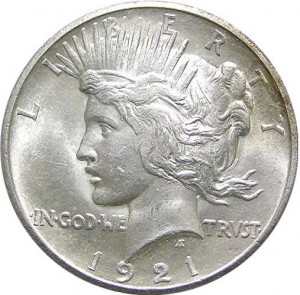 Several readers asked about the timeline for the president’s signature on H.R. 6192, 1921 Silver Dollar Coin Anniversary Act, and whether he signed the bill.
Several readers asked about the timeline for the president’s signature on H.R. 6192, 1921 Silver Dollar Coin Anniversary Act, and whether he signed the bill.
- H.R. 6192: 1921 Silver Dollar Coin Anniversary Act
Sponsor: Rep. Andy Barr (R-KY)
Passed the House of Representatives — Sep 22, 2020
Passed the Senate with amendments — Dec 17, 2020
LAST ACTION: Presented to President. — Dec 24, 2020
According to the Government Printing Office, the United States government’s official publisher, H.R. 6192 was presented to the president on December 24, 2020. The U.S. Constitution, Article I, Section 7, Clause 2 says that the president has ten days to act. If the president does not sign the bill and Congress is in session, the bill becomes law without the president’s signature. If Congress adjourns during that ten-day period, an unsigned bill is vetoed, called a pocket veto.
Documents from the Justice Department notes that the ten-day period does not include Sunday. A follow-up call to the Justice Department noted that Christmas Day does not count as part of the ten days, but New Years Day counts. The Clerk of the House’s office confirmed this information.
The president has until Wednesday, January 6, 2021, to act on the bill. If he does not sign H.R. 6192 into law, it will be the victim of a pocket veto since the 116th Congress formally adjourned sine die (without a date) the morning of Sunday, January 3, 2021, as constitutionally required.
Since watching numismatic legislation has been a feature of the Coin Collectors Blog (since 2005), the White House Press Office would post bill signings on whitehouse.gov. Unfortunately, the current administration has provided uneven coverage of bill signings not in the news. The GPO will probably publish this news before the White House releases the information.
